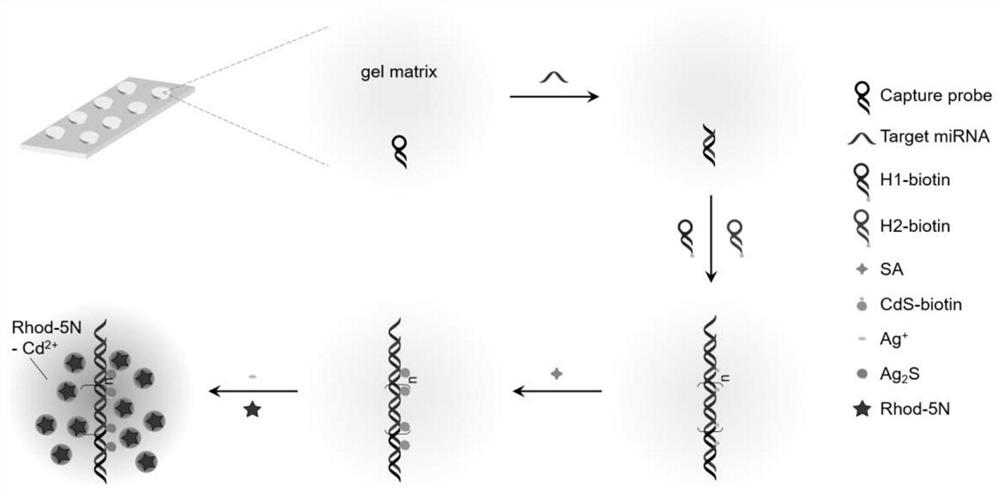Fluorescence analysis method based on HCR and cation exchange reaction of hydrogel
A cation exchange and fluorescence analysis technology, applied in the field of molecular detection, can solve the problems of cumbersome operation, limit the detection of trace analytes, etc., to improve the reaction efficiency, facilitate the detection of low-abundance substances, and increase the load.
- Summary
- Abstract
- Description
- Claims
- Application Information
AI Technical Summary
Benefits of technology
Problems solved by technology
Method used
Image
Examples
Embodiment 1
[0036] Embodiment 1: in combination with figure 1 , Silanization of glass sheets and preparation of hydrogel arrays
[0037] (1) Preparation of silanized substrates: Ultrasonic cleaning of ordinary glass sheets with acetone, ethanol and deionized water for 2 minutes respectively, blowing dry with nitrogen gas, and then treating them with a plasma cleaner to activate surface hydroxyl groups, and then putting them into 0.05% (v / v) silylating agent (3-acryloyloxypropyltrichlorosilane) in anhydrous toluene for 1 hour in a nitrogen-filled glove bag. Afterwards, the glass slides were cleaned with toluene, ethanol and deionized water, blown dry with nitrogen gas, and cured in an oven at 100°C for 2 hours, and stored in a dry box for future use.
[0038] (2) Preparation of hydrogel array: first prepare the prepolymer solution, 7.5% (v / v) PEG-DA (MW700), 22.5% (v / v) 20mM PEG-DA aqueous solution (MW 3400), 40% (v / v) PEG (MW 200), 15% (v / v) 20mM Acryl-PEG-COOH in water, and 10%
Embodiment 2
[0039] Embodiment 2: in combination with figure 2 , taking miRNA-21 as an example to illustrate that the fluorescence analysis method based on hydrogel HCR and cation exchange reaction is used for the detection of microRNA
[0040] (1) Probe modification: Activate the carboxyl group of the hydrogel array with 0.4M EDC / 0.1M NHS MES buffer (25mM, pH5.5) at room temperature for 40 minutes, add 10μL of 0.5μM capture solution to each array spot after washing Probe CP, placed in a humid chamber overnight at room temperature.
[0041] (2) Hybridization chain reaction: first, drop 10 μL containing different concentrations of standard miRNA or samples to be tested at each array point, incubate at 37°C for 1 hour, then add 10 μL of an equal volume mixed solution of 1 μM hybridization chain hairpin H1 and H2 dropwise after washing, Incubate at 37°C for 2 hours, the DNA single strand of the capture probe triggers the hybridization chain reaction between H1 and H2, and assembles at the se
PUM
 Login to view more
Login to view more Abstract
Description
Claims
Application Information
 Login to view more
Login to view more - R&D Engineer
- R&D Manager
- IP Professional
- Industry Leading Data Capabilities
- Powerful AI technology
- Patent DNA Extraction
Browse by: Latest US Patents, China's latest patents, Technical Efficacy Thesaurus, Application Domain, Technology Topic.
© 2024 PatSnap. All rights reserved.Legal|Privacy policy|Modern Slavery Act Transparency Statement|Sitemap



